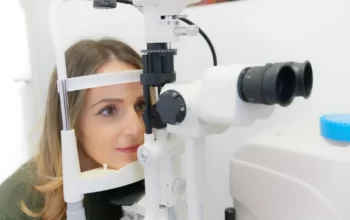
Cataracts are a typical visual impairment. Cataracts affect more than 24 million Americans over the age of 40, and 50% of them will have the condition by the time they are 75.
Your eye’s natural lens can become clouded, which is a cataract. Your lens becomes progressively more clouded as the condition worsens, obstructing clear light from reaching the retina. As a result, the condition of one’s vision gradually deteriorates. Fortunately, cataract surgery makes it simple to get clear vision again.
An artificial intraocular lens (IOL) is placed in its place after the clouded lens of your eye is removed during cataract surgery. Despite the fact that cataract surgery is a successful method of improving your vision, it’s important to realize that there are some situations where you might require glasses even after the procedure.
What Is A Cataract?
Cataracts occur when the natural lenses in your eyes become cloudy as a result of proteins deteriorating in them. Your vision will become cloudy or foggy as a result of these proteins clumping together.
Driving at night and focusing on small details while reading or sewing is difficult when vision is foggy. It’s very common to develop cataracts as you age.
What Takes Place During A Cataract Procedure?
Your surgeon will swap out your natural lenses for artificial ones during cataract surgery. Intraocular lenses are these artificial lenses.
You can regain vision clarity with intraocular lenses or IOLs. Depending on the type of lens you select, they might even give you their best vision yet.
Types Of Cataract Surgery
There are currently two primary cataract surgery types available. In the majority of developed nations, including the United States, the first method—phacoemulsification (phaco) cataract surgery—is employed. It is the most popular kind of cataract surgery and only needs a few tiny incisions in the eye.
Phaco cataract surgery is done by hand and involves opening up the eye to access the cataract. The cataract is then fragmented with ultrasonic energy and gently suctioned out in pieces. Following the removal of the cataract, a foldable intraocular lens (IOL) is inserted into the eye just behind the pupil.
Laser-assisted cataract surgery, also known as LACS or laser cataract surgery, is the second kind of cataract surgery that is currently available. In this approach, a laser operated by a computer replaces surgical tools held in the surgeon’s hands to carry out the procedure. The laser is programmed to first make a small incision in the eye, then access the cataract and break up the original cloudy lens.
Indications For Cataract Surgery
Surgery might be a good option for you if cataracts are obstructing your vision.
Your eye’s lens, which has developed cataracts and becomes cloudy, is removed during cataract surgery. Then a clear artificial lens is put in its place, restoring your vision to its previous level of clarity.
The majority of cataracts, which are very prevalent in older people, are a side effect of aging, according to the National Eye Institute (NEI). By the time they turn 80, more than half of all Americans are thought to have cataracts or have had cataract surgery.
The first step in treating cataracts is to try corrective methods, such as new eyeglasses, contacts, reading in brighter lighting, putting on anti-glare sunglasses, or using magnifying lenses. Surgery is your only option if these treatments do not sufficiently improve your vision.
Cataracts should be surgically removed if:
- Other corrective actions don’t offer you any relief.
- Your cataracts’ impact on your vision makes it difficult for you to perform daily tasks like driving and reading.
- Even though the cataract itself has not yet interfered with daily activities, it is preventing the treatment of another vision issue.
According to NEI, cataract surgery is among the procedures that are carried out most frequently in the country. Additionally, it is among the most efficient and safe surgeries ever performed. About 90% of patients with cataract surgery report better vision.

Why Do Some People Still Need Glasses After Having Cataract Surgery While Others Do Not?
Your decision to continue wearing reading glasses, full-time glasses or none at all depends on a variety of factors. These variables include the eye’s general health, the degree of astigmatism, your current eyeglass prescription, and your visual requirements.
Glasses may be required for some or all distances after cataract surgery with a monofocal IOL for the patient. Since they focus on just one point, monofocal IOLs have been around for a while and are designed to give you the best-uncorrected vision possible. Many people who opt for monofocal IOLs set them for distance vision and use reading glasses for close-up work. On the other hand, someone whose IOLs are set to correct distance vision would require glasses to see distant objects clearly.
Monovision, which is distance vision in one eye and near vision in the other, is another option for monofocal IOLs. Your eye doctor might advise trying this method first with contact lenses if you’re thinking about monovision to see how well you adapt. Monovision might not be the best strategy for you if you need a clear, precise vision.
Your cornea’s curvature is off, which is known as astigmatism. IOLs that correct astigmatism can also be used to lessen the need for glasses. Astigmatism is corrected by these monofocal IOLs, allowing you to see clearly at a single distance without the need for glasses. You might still need glasses for some tasks.
IOLs with multiple focal zones or rings are called multifocal IOLs and they offer cutting-edge technology. You might be able to clearly see distant, intermediate, and close objects depending on where light concentrates through the zones. Although each person’s ability to read and perform other tasks without glasses is different, multifocal IOLs are typically best placed in both eyes.
Regardless of the type of lens you choose, you might still occasionally need to wear glasses, but if your IOLs are chosen properly, they can significantly lessen your reliance on glasses. With the help of your ophthalmologist, you can choose the IOL that most closely matches your visual requirements and way of life.
After A Surgery, What Happens?
Your surgeon will provide you with detailed instructions for proper recovery following surgery. You’ll also need to go to follow-up appointments so the doctor can monitor your recovery.
Avoiding rubbing your eyes is one of the most crucial instructions you will be given. Rubbing your eyes while they are healing could reopen the corneal incision.
Additionally, it is best to avoid getting any germs in your eyes because they will be more vulnerable to infection as they heal. To hasten the healing process and prevent you from rubbing your eyes, your doctor will prescribe you eye drops.
Do I Still Need Sunglasses After A Cataract Procedure?
Yes, wearing sunglasses to protect your eyes from the sun is necessary after cataract surgery. Your eyes are healing from surgery, making them more susceptible to the sun’s rays than usual.
You must always wear sunglasses when you are outside. The sun’s UV rays can harm skin whether it’s sunny or raining.
To shield your eyes from these UV rays, you must wear sunglasses. Additionally, you should wear sunglasses with a wide brim if you plan to be outside in the middle of the day.
From around 10 am to 2 pm, the sun is at its brightest. You must shield your eyes because your risk of sun damage is higher during this time.
Factors Impacting Whether You’ll Need Glasses After Cataract Surgery
You may need to wear glasses after cataract surgery depending on a number of variables. These include:
- Your overall eye health
- Whether you have astigmatism
- Your current eyeglass prescription
- The type of IOL used during your procedure
The IOL You Choose Matters
IOLs used in traditional procedures are monofocal. This indicates that they can only clearly focus on one visual point. After cataract surgery, if you select a monofocal IOL, you might still need glasses for close-up work even though you can see clearly at a distance.
But recent developments in IOL technology have led to a wide variety of high-end IOL options. Many premium IOLs are multifocal and provide you with the ability to focus clearly at multiple distances. After cataract surgery, using a high-quality IOL will frequently lessen, if not completely eliminate, your need for glasses.
Other benefits of using premium (multifocal) IOLs include:
- Better range of vision
- Improved vision in a wide range of lighting conditions
- Improved ability to read and perform other near vision tasks
Conclusion
Your ophthalmologist will go over your options for glasses after surgery before you undergo cataract surgery. There isn’t a single best choice for post-surgery glasses because everyone has different needs and requirements. Cataract surgeons advise waiting until your eyes have fully recovered before getting fitted for a new set of glasses.
You might not need to make significant adjustments to your eyeglasses as long as your frames still fit the updated lens. The IOL and subsequent glasses should be chosen based on your individual lifestyle and vision priorities, say, ophthalmologists.
Read more about: After Cataract Surgery: Dos And Don’ts Can Cataracts Come Back After Removal? Cataract Surgery: 5 Tips To Minimise Recovery Time



